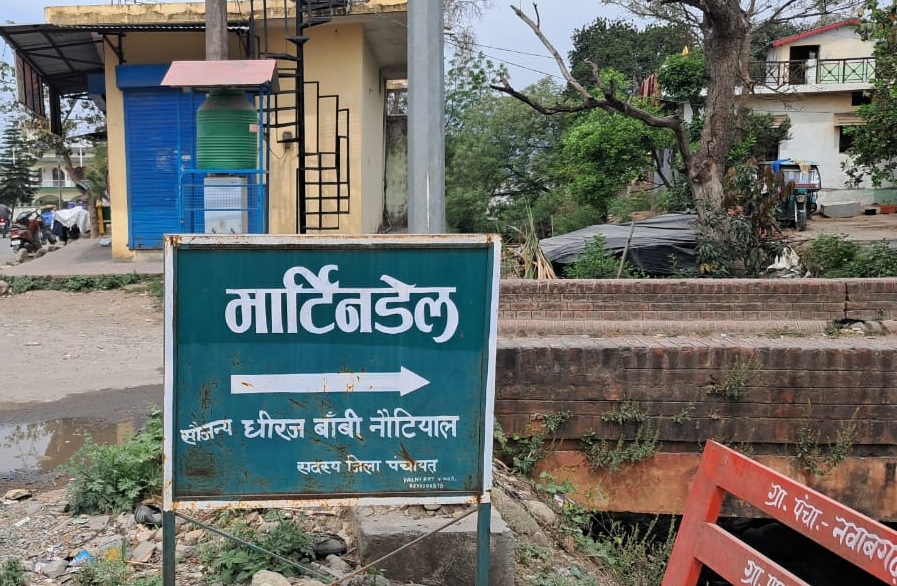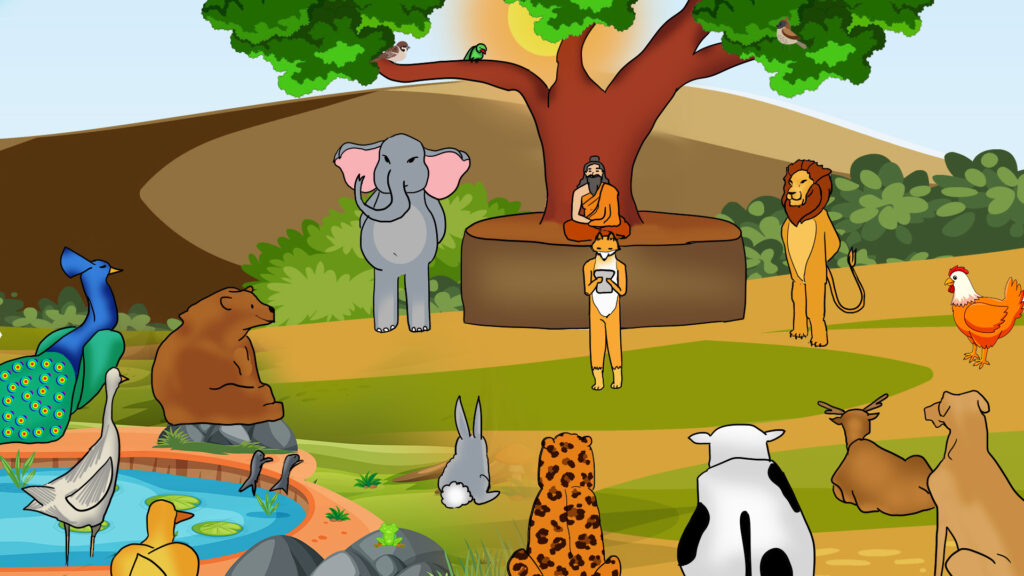 This Yamuna valley where I live, roughly stretches a hundred kilometers, between Paonta Sahib and Dehradun, in the Shivaliks. Here, Tons River joins Yamuna, as they both come tumbling out of the mountains, into the Terai. From Pathans, to Mughals, to Maratha, and finally to British – they all came, ruled this region and eventually left. Currently, it is the migrant labor (“Purabiya”) from Bihar and Uttar Pradesh, who is drawn to this region for work since the Selaqui Industrial area has come up in a big way.
This Yamuna valley where I live, roughly stretches a hundred kilometers, between Paonta Sahib and Dehradun, in the Shivaliks. Here, Tons River joins Yamuna, as they both come tumbling out of the mountains, into the Terai. From Pathans, to Mughals, to Maratha, and finally to British – they all came, ruled this region and eventually left. Currently, it is the migrant labor (“Purabiya”) from Bihar and Uttar Pradesh, who is drawn to this region for work since the Selaqui Industrial area has come up in a big way.
This mixed past has left behind a legacy of interesting place names. Look at my own village- Herpatpore: some retired colonial sahib decided to come and settle down here in the early part of the 20th Century. Esquire Herbert arrived here with his spinster Scottish aunt who was an architect, foreman, and a supervisor, all rolled into one. She got the Sal forest cleared and threw up a couple of crude buildings, the remains of which survive today. I can imagine her in her solar topee, arms akimbo, shouting quick instructions to a gang of native labor: Hurry up! If you have seen Victorian dramas, you have seen her. Herbert, a doctor, dedicated himself to the sick and the old in the region. His work today is carried on by a mission hospital. Yes, that big compound whence come the Hallelujah chorus every Sunday, is the oldest private hospital in this area.
Then, there is another village “Goodrich”, a little distance to the north. Migrant laborers have lived there for many generations. No one today in that village can spell “Goodrich” but they all talk about how good was old Goodrich sahib with a gun- and his exploits in the Terai forest.
Aha, I forgot “Martindale”! That is another village 4-5 kilometers from my home, to the east. It has lichi groves, reputedly started by Miss Martindale at the time when Lord Curzon took over as the viceroy of India. Today, this farm is run by an ambitious young Indian man, claiming to be a distant relative. Miss Martindale never married; It is believed that she left behind the fashionable circuits of Europe in her youth and surrendered herself to a reclusive life here, along with an older brother. Some say that the two frequently fought and both met with a violent end while still young.
How do I know all this about Ms Martindale, Mr Goodrich, and Esq Herbert? Ram Sanehi is my source of all the local history, genealogy, and gossip. When the British came first into this area, they brought along many families from Eastern UP and Bihar, who cleared the forest, planted tea bushes, and settled down for good- somewhat like the “Girmitiya” labor of colonial days. The children, women, and men, who worked the tea gardens and the surrounding forest two centuries ago, have been successively replaced by their new generations. They flourish and populate this area now and still use a Bhojpuri-like dialect.
Ram Sanehi is one of them. He is a sort of carpenter. I said “sort of” because I haven’t seen him making tables, chairs, stools, etc. Nor does he make doors or window frames. But his driftwood pieces fetch him a good price. He picks them up from the riverbed during the winter and then “jazzes” them up: a little rubbing here and there with Emory paper, sawing off a few unwanted extensions, and a good coat of varnish. It ends up like a disembodied hand or a funny face smiling back at you. Who would buy artistic but essentially useless pieces of driftwood in these backwaters, you may wonder?
Well, the mission hospital gets regular visitors from the West: missionaries and medical students wanting credits for exposure to “third world” health disorders, regularly visit here. Of course, they get diarrhoea as soon as they arrive, for which I suspect, they get no credits from their universities! These caucasian minds are able to see a face or a bird in a silly piece of gnarled old wood – and pay handsomely for it. Even when they can’t see it, Ram Sanehi, as a third world Art Connoisseur encourages them to see it, by poking his finger here and there in the tangled roots and mumbling something mysteriously.
Ram Sanehi loves to talk but also has a finesse about the way he conducts his “talking business”. That is what attracted me to him. His home and shop- with all sorts of queer displays, are right on my street. I can’t help but stop and look at the display, and then exchange a few words with him.
*************************
“Ram Sanehi, why did brother and sister fight?”
Referring to Martindales, I asked him one morning. He stubbed his bidi right into the driftwood he was working with. He did it carefully, right into the knot, which was coming up as some weird face. Later, he explained that he was creating an eye through that “careless” act. Coming back to the important business of the strange relationship between the siblings, he said:
“Their parents had died when Anne was a mere child. But the brother, Phil, almost ten years older, took care of her, like a father. So, when he left the army, to settle down here, he brought her out from England…”
Ram Sanehi stopped. A woman had picked up a piece of driftwood and was examining it carefully. Because of her tan, she could have passed off as a native- till she opened her mouth: “This, a face?”
“Face” was said with a huge vowel: Faaaice! Perhaps, an Australian, visiting the mission hospital, I guessed.
“No, no. This is a clothes peg.” Ram Sanehi corrected her. She looked disappointed. He decided to help her at once: “Of course, if you look at it like this-“. He grabbed the piece, turned it around, and continued, with a mischievous smile- “it looks like a forest spirit with many horns..”
Back and forth a few times, the woman bought it for Rs 1500 finally and was gone, probably to share the picture on Facebook. I got the chance to push him back on the track:
“Why did they fight, when they had so much love?”
“You see, Phil was getting on in age. He could not marry till Anne was married and settled. And she, Oh my God, she was so headstrong! She just would not marry..”
The woman was back: “RAM SHUN EYE – see, this is broken.” One of the horns had come unstuck! Ram Sanehi promised to stick it right back. No question of refund for such a small thing!
****************************
A few weeks later, I caught him yawning in the sun in front of his shop.
“So, why did Anne refuse to marry?”
Ram Sanehi dealt with customers as he spoke to me in “shorthand” aside. He ran a small grocery shop too. Village urchins pestered him for a little of this and a little of that. Finally, he offered me a little stool to sit on and confided in a serious tone-
“Goodrich had a daughter- Daphne; the same age as Anne. Both were inseparable. They say, that they had made a pact that they would never marry! God knows the truth…”
Another interruption: a kid, with limited numeracy, had bought a crate of eggs and insisted on counting and checking out each one of them for cracks, before paying up. A little bored, I looked to the north. Tea garden shimmered in the distance. Nearer, next to our village, there were little farms, wherein wheat was ripening to an amber gold. It was late spring. Just the right time of the year to stroll in the tea gardens and look at the Chakrata mountains in the distance.
Finally, the kid left with his crate of eggs and Ram Sanehi turned to me:
“Old man Goodrich was always out on the hunt. He could not bother less. But Phil hated this friendship between Anne and Daphne. Daphne did have some young suitors but had no time for them. Like that young Railway guard – oh my God! – who came all the way from the Calcutta and left the very next day. Why? Anne and Daphne left on a picnic, without inviting him!”
“All that is fine. Why did the brother and sister have to die?” I was getting a little impatient.
“Goodrich and Phil, both gave an ultimatum to the girls, to mend their ways. But Phil did not stop with that. He went ahead and shared his worries with Padri Johnson. You see, they had a little church for these 5-6 families then. It is still there, of course, renovated and expanded..”
“Where is it?”
“Haven’t you seen it in the mission hospital?”
“Oh yes. But I didn’t know it was that old… So, then what happened?”
“What do you think the Padri did? In the Sunday sermon, he talked about the sinful ways of the young looking at the girls..” He gave me a knowing look, cleared his throat, picked up that weird piece of wood, and began viewing it from different angles. Love viewed from different perspectives, could look innocent, funny, or strange- just like that knot of driftwood.
Ram Sanehi wiped his nose on his sleeve and carried on:
“The congregation was scandalized. The girls were deeply hurt. The next day, Anne used Phil’s double-barrel hunting rifle to end her life. Phil had gone to the river. She sat in a high chair, stuck the muzzle under her chin, and pressed the trigger with her toe. When Phil returned and saw her body toppled down on the floor, he was so overwhelmed with sadness that he followed her example then and there. Anglo-Indian community, all the way from Mussoorie to Meerut, gathered for the funeral..”
“What happened to the Padri?”
“Of course, he was defrocked and sent home – instead of Kalapani, which he really deserved, if you ask me…” Ram Sanehi said with some “righteous anger”.
I got up to go as it was getting late for my walk.
************************
Few days later, I was getting some repair work done at my home. I had invited the labor from the neighborhood, for the sake of convenience. Shibu was one of them. Shibu is around 50, the same age as Ram Sanehi. Around 11 am, the laborers took a break and sat down with a cup of tea. We began talking about the upcoming panchayat elections. Who could be a good candidate for the post of our village Pradhan? I suggested Ram Sanehi, just for fun. After all, he was so knowledgeable. Shibu reacted rather violently:
“Ram Sanehi? No way. He talks too much.”
“But isn’t that a requirement for the village headman?” I rejoined.
“Yes, but he makes up half the things. Nothing will be done in the village and he will keep spinning stories..” Shibu came back at once.
I had to take Shibu’s opinion seriously since he and Ram Sanehi came from the same community and were neighbors. I dug deeper:
“But Shibu, he knows so much about this village, the people here, even the sahibs who lived here before us..”
Shibu spat the tea leaves, put the cup down, and said, waiving both his hands in my face- as if removing some invisible cobwebs: “He knows nothing! He grew up in Pratapgarh, near Prayagraj. He came here when he was in his twenties. He had no skills. A local family adopted him. After coming here, old man Shambhu taught him a little woodwork… How can an outsider become the village headman? And who needs his stories anyway?”
**********************
A few days later, I confronted Ram Sanehi:
“Why do you make up wild stories? I spoke to the pastor in the church. He has old records for last two hundred years. He says that Anne and Phil returned to England and died in their happy old age; and that Goodrich never had a daughter by the name of Daphne. Why do you indulge in such untruths?”
I waited and looked at his face carefully. He took his own time to dispatch a few customers in the shop. Then, he turned to me with irritation on his face:
“What do you mean by truth and untruth? Look, this very mission hospital declared that my aunt had Diabetes but she died of Malaria, of all things! Look at this rundown one-and-a-half room I call home. It wouldn’t be standing here if everyone spoke the truth… OK, the brother and sister did not die here. They died of old age in England. Is that your problem? Maybe the other girl’s name was not Daphne but something else. Maybe her father was not Goodrich but someone else. Why do you badger me with such details? Why do I have to remember all this?” He was angry and defiant, but in a somber way, suited to his 50+ years on earth.
My attempts to get an admission of guilt out of him were useless. Like the average villager in these parts, he would submit only to an extent. Past that, he had dug in his heels, like a mule and stuck with the story. Days passed and I began to see that he loved joining the dots (as in data science!) and talking imaginatively (as in marketing!). He was an artist after all, wasn’t he? Seeing the potential in a situation -or a driftwood- that was his forte.
Beyond this was the old question: what is “real” after all? I remembered the old Vedantic story of the farmer who did not cry at the death of his young son; When asked about it, he said: I got up from my sleep and did not know for whom should I cry? the four beautiful princes, I had as a king in my dream- or- for this one son?
Interestingly, I still visit him, buy him a cup of tea, and listen to his stories with great indulgence. I also hear him making sales-pitch to his esteemed overseas clients- and often getting better of them in the bargain!
Such are the joys of living in my village- Herpatpore!
(Satyendra Srivastava)





